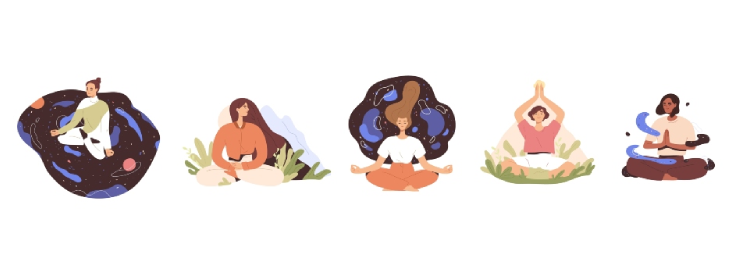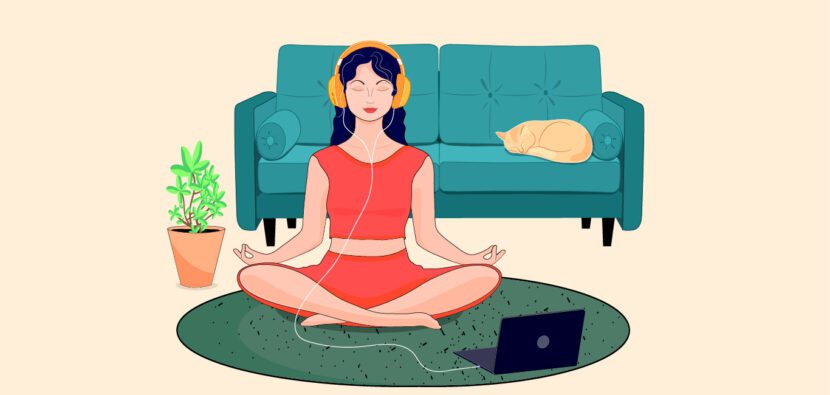In the hustle and bustle of modern life, finding moments of peace and tranquility can seem like a distant dream. Yet, amidst the chaos, lies an essential component of well-being that is often overlooked: relaxation. Relaxation is a fundamental necessity for maintaining optimal physical, mental, and emotional health. Hence, knowing different techniques for relaxation is crucial.
Picture this: a world where stress and tension melt away, where the mind is calm, and the body is at ease. Individuals are better equipped to navigate life’s challenges with resilience and grace, to savor moments of joy and connection, and to live each day with purpose and fulfillment. This is the transformative power of relaxation.
But what exactly is relaxation, and why is it so important? At its core, relaxation encompasses a state of deep rest and restoration, where the body and mind release tension and the nervous system shifts into a state of equilibrium. It is a process of letting go, surrendering to the present moment, and allowing oneself to simply be.
In the following exploration, we will delve into the myriad benefits of relaxation, examining its profound impact on mental health, physical well-being, productivity, relationships, and overall quality of life. From stress reduction techniques to mindfulness practices, we will uncover the diverse array of techniques for relaxation in our daily lives.

Why is Relaxation Important?
This article delves into why relaxation is important and some of the most effective relaxation and stress relief techniques, offering practical tips to incorporate them into everyday life.
Relaxation is crucial for both mental and physical well-being, playing a fundamental role in maintaining overall health and quality of life. Here are several reasons why relaxation is important:
Stress Reduction:
Relaxation techniques are highly effective in reducing stress levels. Stress is a natural response to challenging situations, but chronic stress can have detrimental effects on health, leading to a range of physical and mental health problems such as anxiety, depression, cardiovascular diseases, digestive issues, and weakened immune function. By engaging in relaxation activities, individuals can activate the body’s relaxation response, counteracting the harmful effects of stress and promoting a sense of calmness and balance.
Improved Mental Health:
Relaxation is essential for promoting mental health and emotional well-being. Chronic stress can take a toll on mental health, contributing to symptoms of anxiety, depression, irritability, and mood swings.
Relaxation techniques such as mindfulness meditation, deep breathing exercises, and guided imagery can help quiet the mind, reduce negative thinking patterns, and enhance emotional resilience. Regular relaxation practice has been shown to improve mood, increase feelings of happiness and contentment, and foster a greater sense of inner peace and clarity.

Enhanced Physical Health:
Relaxation is not only beneficial for mental health but also for physical health. Chronic stress has been linked to a wide range of physical ailments, including high blood pressure, heart disease, obesity, diabetes, gastrointestinal disorders, and chronic pain conditions.
By reducing stress levels, relaxation techniques can help lower blood pressure, improve heart health, boost immune function, regulate hormone levels, and alleviate symptoms of pain and inflammation. Additionally, relaxation promotes better sleep quality, which is essential for overall physical health and recovery.
Increased Productivity and Performance:
Relaxation plays a crucial role in enhancing productivity, focus, and cognitive performance. When the body and mind are in a relaxed state, individuals are better able to concentrate on tasks, problem-solve effectively, and make clear decisions. By taking regular breaks for relaxation and self-care, individuals can prevent burnout, improve work-life balance, and sustain high levels of productivity and performance over the long term.
Strengthened Relationships:
Relaxation can also improve interpersonal relationships by promoting better communication, empathy, and connection with others. When individuals are stressed or overwhelmed, they may be more prone to irritability, conflict, and misunderstandings in their interactions with others. Engaging in relaxation activities together, such as going for a walk, practicing yoga, or enjoying a leisurely meal, can strengthen bonds, foster mutual support, and enhance the quality of relationships.
Enhanced Quality of Life:
Ultimately, relaxation contributes to a higher quality of life by promoting overall health, happiness, and fulfillment. When individuals prioritize relaxation and self-care, they experience greater satisfaction in all areas of life, including work, relationships, leisure, and personal growth.
By cultivating a lifestyle that incorporates regular relaxation practices, individuals can enjoy greater resilience in the face of challenges, a deeper sense of purpose and meaning, and a more profound appreciation for the present moment.

Powerful Techniques for Relaxation
In today’s fast-paced world, stress has become an inevitable part of daily life for many individuals. From the pressures of work and academic responsibilities to personal relationships and societal expectations, stress can manifest in various forms and affect both mental and physical well-being. However, amidst the chaos, there are numerous techniques available to help individuals unwind, relax, and alleviate stress.
Let’s explore some of the most effective relaxation and stress relief techniques, offering practical tips to incorporate them into everyday life:
Mindfulness Meditation:
Mindfulness meditation is a centuries-old practice rooted in ancient Buddhist traditions, gaining popularity in contemporary psychology and wellness circles for its profound effects on stress reduction and overall well-being. The essence of mindfulness meditation lies in being fully present in the moment, observing thoughts and sensations without judgment.
To practice mindfulness meditation, find a quiet and comfortable space, sit or lie down in a relaxed position, and focus on your breath. Notice the sensation of each inhale and exhale, allowing thoughts to come and go without attachment. Regular mindfulness meditation practice can help calm the mind, reduce anxiety, and enhance self-awareness.
Progressive Muscle Relaxation (PMR):
Progressive Muscle Relaxation (PMR) is a relaxation technique developed by American physician Edmund Jacobson in the early 20th century. PMR involves systematically tensing and then relaxing different muscle groups in the body, promoting physical relaxation and reducing tension.
To practice PMR, start by tensing a specific muscle group (e.g., the muscles in your shoulders) for about 5-10 seconds, then release the tension and allow the muscles to relax completely for 20-30 seconds. Repeat this process with different muscle groups, working your way through the entire body, from head to toe. PMR can help relieve physical tension, alleviate muscle soreness, and promote overall relaxation.
Deep Breathing Exercises:
They are simple yet powerful techniques for reducing stress and promoting relaxation. Deep breathing stimulates the body’s relaxation response, slowing down the heart rate, lowering blood pressure, and promoting a sense of calmness.
One effective deep breathing exercise is diaphragmatic breathing, also known as belly breathing. Sit or lie down in a comfortable position, place one hand on your abdomen and the other on your chest. Inhale deeply through your nose, allowing your abdomen to expand as you breathe in, then exhale slowly through your mouth, feeling your abdomen contract. Repeat this process for several minutes, focusing on the rhythm of your breath and letting go of tension with each exhale.
Yoga and Tai Chi:
Yoga and Tai Chi are ancient practices that combine physical postures, breathing techniques, and mindfulness to promote relaxation, flexibility, and inner peace. Both practices emphasize the connection between mind and body, fostering a sense of harmony and balance.
Yoga encompasses a wide range of styles and techniques, from gentle Hatha yoga to more dynamic Vinyasa or Power yoga. Tai Chi, on the other hand, is a Chinese martial art characterized by slow, flowing movements and deep breathing.
If you want to relax in 5 minutes, browse this site to view the best video.
Regular practice of yoga or Tai Chi can help reduce stress, improve flexibility and strength, and enhance overall well-being. Whether attending a class or following online tutorials, incorporating yoga or Tai Chi into your routine can be beneficial for relaxation and stress relief.
Visualization and Guided Imagery:
Visualization and guided imagery harness the power of the imagination to promote relaxation and reduce stress. By creating vivid mental images of peaceful and calming scenes, individuals can shift their focus away from stressful thoughts and emotions.
To practice visualization, find a quiet place to sit or lie down, close your eyes, and imagine yourself in a serene environment, such as a beach, forest, or mountaintop. Engage all your senses in the visualization process, imagining the sights, sounds, smells, and sensations of your chosen setting.
Guided imagery involves listening to recordings or guided sessions led by a trained facilitator, who provides instructions and prompts to guide your imagination through relaxation exercises. Whether through self-guided visualization or guided imagery sessions, incorporating these techniques into your daily routine can help calm the mind, reduce anxiety, and promote emotional well-being.
Engaging in Creative Activities:
Engaging in creative activities can be an effective outlet for stress relief and relaxation. Whether it’s painting, drawing, writing, gardening, or playing a musical instrument, creative expression allows individuals to channel their emotions and thoughts into constructive pursuits.
Creativity has been shown to have therapeutic effects on mental health, providing an avenue for self-expression, exploration, and catharsis. Engaging in creative activities can help reduce stress levels, boost mood, and foster a sense of fulfillment and accomplishment.
Conclusion:
In conclusion, relaxation and stress relief are essential components of maintaining overall health and well-being in today’s fast-paced world. By incorporating techniques such as mindfulness meditation, progressive muscle relaxation, deep breathing exercises, yoga, Tai Chi, visualization, guided imagery, and creative activities into your daily routine, you can effectively manage stress, promote relaxation, and enhance your quality of life.
Experiment with different techniques to find what works best for you, and remember to prioritize self-care and relaxation in your journey toward greater balance and tranquility.
Join us on this journey as we unravel the mysteries of relaxation and discover how embracing this essential aspect of self-care can lead to a life of greater balance, resilience, and joy. Together, let us embark on a quest to reclaim our inner peace and unlock the full potential of our well-being.
